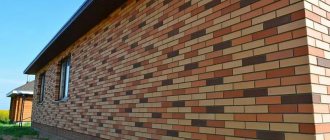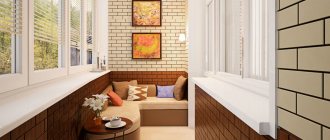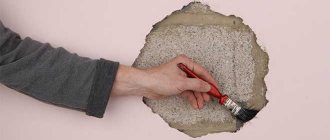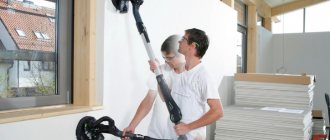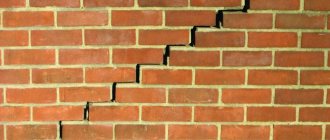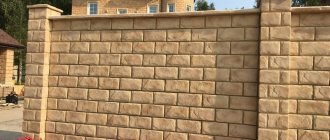Good brickwork will last a very long time.
But in order for it to maintain its excellent appearance and perform all the functions assigned to it, the masonry must be periodically repaired. Even through very small cracks, moisture can penetrate a wall or slab, and when it freezes or thaws, it will destroy the laid brickwork. Moisture is the main, but not the only pest of masonry. Depending on the deformation and problems encountered, repair of brickwork can be carried out in several directions.
Sealing cracks
If cracks appear again, look for the problem of their origin.
Be sure to clean any existing cracks from dirt and dust. Then fill the cracks with liquid cement mortar with finely sifted sand (in a ratio of 1:3). It must be poured inside using, for example, a syringe.
If the cracks are more than 5 mm, then to repair them it is necessary to install an anchor or beam. In other words, shift the surface of the wall to a depth of half a brick and a width of 1-2 bricks. Then fill the crack with cement mortar and install a beacon.
If cracks appear in this place again, then measures will have to be taken to establish and eliminate the causes of its formation.
Causes of damage and stages of their destruction
Depending on the stage of destruction of the wall, there are several ways to restore it.
The reasons why brickwork begins to deteriorate may be as follows:
- different soil densities, and part of the building begins to sag;
- if there are heavy loads on the foundation;
- if during construction, expansion joints were not made;
- subsidence of the foundation can occur due to uneven load on the soil ;
- under the influence of precipitation and moisture.
If one or more reasons are present, damage to the integrity of the brickwork begins, which occurs in several stages:
- first, tension arises in the wall, which cannot be noticed with the naked eye, because so far there is no visible damage;
- on some wall elements barely noticeable damage appears in the form of thin cracks;
- thin cracks unite between themselves and the seams, resulting in serious damage to the wall;
- At the last stage, the wall is destroyed.
In order to prevent destruction of the brickwork, the extent and causes of deformations must be determined at the very initial stages and immediately eliminated.
Seam repair
Don’t wait for the seams to completely fail, update the adhesive composition in time
- First you need to get rid of the old solution. Loose pieces of masonry are removed using a chisel and an entrenching hammer. You will need a brush to sweep away crumbs and dust from the seams.
- Next, you need to moisten the seams and the bricks themselves with a spray. This process is necessary to prevent the bricks from absorbing the new mortar. In addition, this treatment will provide good grip.
- At the next stage, a pointed trowel and jointing are used. They will give the same type of seam as the old one.
- All that remains is to fill the prepared seam with a new solution and remove the excess with a brush.
Stages of deformation of brickwork
- Tension in the structure that does not entail damage to the masonry.
- The appearance of minor cracking in some bricks, so-called hairline cracking.
- Connection of several clefts with vertical seams. This contributes to the delamination of the masonry.
- Gradual deformation of the base of the wall.
Already at the first signs of such manifestations, it is important to understand the reasons and monitor the quality indicators of the laid brick. It is necessary to monitor the binding of external walls, the height of the seams, maintaining a horizontal base and filling these gaps with the composition
Why is it important to repair and restore on time?
If defects are not repaired in a timely manner, the wall may become unsafe in the future. It will have to be demolished and the brickwork re-done.
A few more consequences of lack of timely repairs:
- No energy saving.
- Reducing the strength of a brick wall.
- Destruction of the cladding.
- The appearance of mold, mildew and dampness.
- Heat loss.
- Freezing of brick walls in winter, which leads to its destruction.
This entire list of consequences will not be long in coming if you neglect repairs.
After a visual inspection of the masonry, it is recommended to call a specialist or begin restoration yourself. If you have no experience in repair work, then it is better not to take risks and leave the matter in the hands of professionals.
Average prices in the Russian Federation for work per m2
The price of repair work directly depends on its complexity, as well as the amount of material used and the number of workers. The cost is also affected by the region of the country, conditions for carrying out work, and their speed.
Average prices in Russia vary:
- Restoration of brickwork - from 400 rubles per square.
- Restoration of seams with lime - from 300 rubles.
- Joining seams - from 100 rubles per linear meter.
- Sealing cracks with jointing – from 150 rubles.
- Sealing cracks using an electromechanical method – from 200 rubles per meter.
- To restore brick walls using brush strokes you will have to pay from 400 rubles per square meter.
What defects may occur in brick walls?
It is recommended to constantly monitor the brickwork: any changes in its condition can lead to premature destruction of the wall. To prevent this from happening, the masonry is inspected, identifying shortcomings.
The most common defects on brick walls are:
- cracks,
- destruction of seams,
- the appearance of holes,
- formation of an uneven surface,
- as well as dampening of some sections of the wall,
- their freezing,
- sagging and delamination of masonry rows.
Each defect is preceded by a cause that served as a catalyst for the problem.
Cracks
Compared to other types of materials used to construct walls, bricks are the most susceptible to defects.
For example, cracks are the most common problem in brickwork. When examining a building, they are very easy to notice - they thin the strength of the structure like a net.
Large cracks in load-bearing walls pose a threat to the complete collapse of the building. If the crack has a horizontal or vertical location and is located in the brickwork above the doorway, such placement indicates a strong decrease in the load-bearing capacity of the structure.
There are cracks:
- Deformation.
- Temperature.
- Constructive.
- Shrinkable.
They can have different directions, be curved, through or superficial. The crack may be stable or progressing. The depth ranges from 0.1 to 1 mm or more.
The main causes of cracks that appear in brickwork are overloading the walls - then the cracks will be vertical and closed. If the problem is in the middle part of the building and has a vertical direction, then the reason lies in the absence of expansion joints when the wall is long.
The cause of a vertical crack of a rectilinear nature, open along the entire length, will be poor ligation of the brick. Small cracks of shallow depth indicate physical wear and tear of the brickwork, and multidirectional cracks indicate mechanical impact on the wall.
Seam failure
The problem of joint destruction is understood as their delamination, crumbling or loss of individual pieces of grout.
There are several reasons for this:
- incorrectly prepared solution;
- violation of grouting technology;
- violation of the sequence of actions;
- application of the freshly prepared solution.
If the master has chosen the wrong consistency for the grout, it will not fill all the cracks between the bricks. A solution that is too thin will simply leak out of the joints, and a solution that is too thick will be impossible to rub into the cracks.
All this leads to the fact that after grouting, after some time, defects form . If you do not follow the technology for treating the seams before grouting, do not completely clean them of debris and dirt, and do not treat them with clean water, then the solution will lie unevenly, which will also lead to a problem.
Another violation is to fill the seams with the wrong tool. For thin seams between bricks, jointing is necessary - this can be done with an ordinary sharp knife.
It is allowed to use the prepared solution or grout only when it has stood for a while. You need to work quickly so that the solution itself does not harden on the spatula . If excess occurs, it is immediately removed from the brickwork.
The appearance of holes
Through cracks or holes in a brick wall pose the greatest danger to the reliability of the building structure. If a visual inspection reveals holes in the wall, then the cause is deformation of the foundation. In this case, the prerequisite for this was not the shrinkage of the entire structure, but the influence of natural elements or the fall of a tree.
The reasons for the formation of through-type holes in the wall are:
- No bandaging of seams when laying bricks.
- Lack of brickwork reinforcement.
- No concreting at corners.
- The occurrence of increased stress in the masonry.
If geological work was skipped before construction, this also affects the appearance of through holes in the brick wall. In this case, repairs are no longer an option: the building is often considered unsafe and sent for demolition.
If there are constant water supply or sewerage leaks, holes may also appear on the brick wall - because of this, the soil becomes wet and the foundation collapses. The building will require major renovation. This article will tell you how to repair a hole in a brick wall.
Uneven surface
The main reason for an uneven wall surface is uneven brickwork. This is due to several factors:
- gross violation of technological standards;
- poor quality building material;
- improper installation of thermal insulation;
- using hollow brick instead of solid brick;
- poorly mixed solution.
Uneven brickwork has an unattractive appearance and therefore requires repair. Often the solution is to use putty.
Visual differences
It is important to understand the depth of the defects. The cracks may be at the very top of the brick, almost scratches. There are very deep defects that go through the entire masonry. The last option is the worst possible. Visually, cracks can be:
- Vertical;
Vertical cracks - Horizontal;
Horizontal crack - Sloping;
Oblique crack - Straight;
Straight crack - Curvilinear;
Curvilinear crack - Closed;
Closed crack - Through;
Through crack - Superficial.
Surface cracks
Repairing cracks also begins with determining their size. And it could be:
- Wide if the gap is wider than a centimeter.
- Medium dimensions, parameters from 5 to 10 millimeters.
- Small, such cracks measure up to five millimeters and are considered the most harmless for the general condition of the brickwork.
It is also worth checking each crack for the level of stabilization and the possibility of expansion in the future. This is done using special tear tests. For the examination, you will need several plaster beacons, as well as plate elements with a special scale. Stabilization is determined by simply gluing paper to the defect or applying a cement strip to the crack.
Regulatory beacon on a crack
Repairs to cracked walls should only be done if they do not continue to expand. First, the process must be stopped and only then all the resulting defects must be corrected.
When the reasons are identified, the shrinkage process is completed, and the cracks no longer widen, the final repair process begins. After applying a strip of paper or a little cement to the defect, you should wait a while. If the item remains intact, then you can begin work. If the deformation continues, then we do not recommend starting any action; it is necessary to resolve the issue with a construction expert.
When does the need arise?
Reinforcement of a brick stone wall by injection is performed in the following cases:
- to stop destructive processes;
- the need arises to create a hydrophobic barrier on the line of moisture penetration through the pores of the building material and cracks in the walls;
- to fill the emerging lumen areas with a dense mass;
- in order to obtain the effect of reinforcement with hardened polymer components;
- strengthen the insulating qualities of the base in grounded structures;
- form a bunch of diverging parts into one whole.
The injection method of forming additional waterproofing in the wall is used in the construction and repair of buildings and structures of various levels of complexity - subway lines, underground parking lots, sewer system collectors, swimming pools, basements, etc.
The composition of the injected injection depends on the level of destruction of the building material and structural differences of the object.
How is the estimate drawn up, what is taken into account when drawing up?
To create an estimate for the repair of brick walls, the contractor takes into account several nuances:
- workers' compensation;
- use of specialized equipment;
- wages for drivers;
- cost of materials for repairs.
The estimate also includes the delivery of material to the site and its unloading. Depending on the type of work, complexity, and accuracy, an estimate is drawn up.
For example, if you need to level a façade wall, more effort and capabilities will be required than when leveling a rough wall - a partition.

